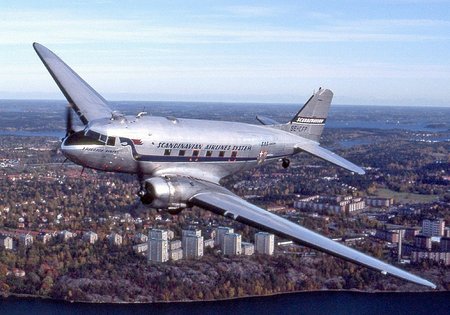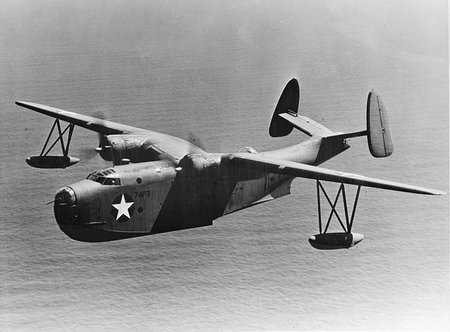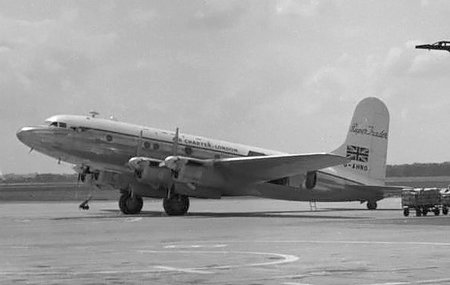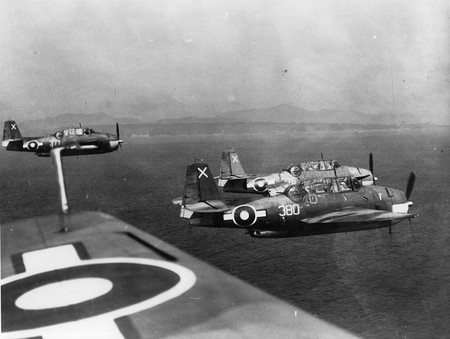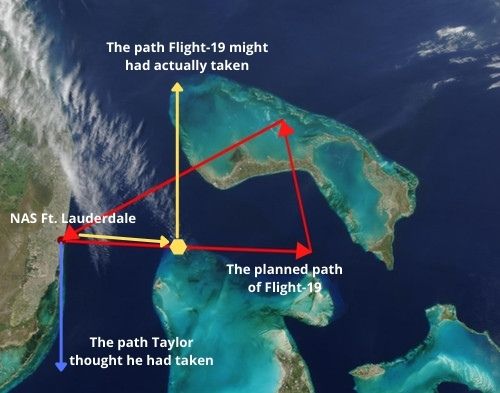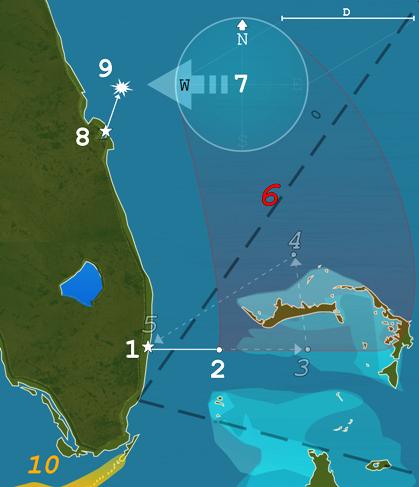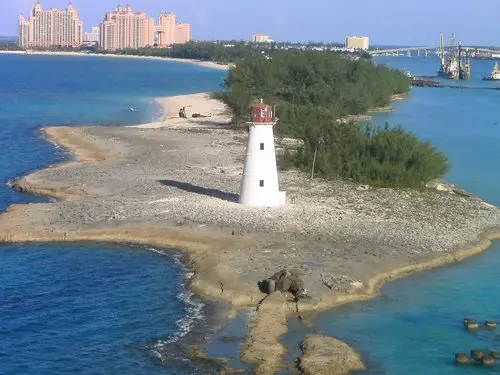This blog contain many fictions, myths, and also facts. It's up to you to choose one or both.
About me

- Agrephino
- Depok, West Java, Indonesia
- My name is Yosafat Jan Diocassa Agrephino. People call me Dio or Yosafat. My birth date is on 8th November 1996. I'm the last child of 4 children. I made this blog just for fun, because i have a lot of free time. One more thing to know, i love peaceful. But if someone got a problem with me, I'll show the real problem
Tuesday, September 20, 2011
Lost Planes In Bermuda Triangle - Fight DC 3
On December 28, 1948, the flight Douglas Dakota DC-3 (NC16002) took off at 10.03p.m. from San Juan airport of Puerto Rico heading for Miami (Florida).
While it was only 50 miles south of Florida, it sent the last message to indicate its position.
Only 20 minutes to go, the flight was never seen or heard of again.
It disappeared in the Bermuda Triangle area with all its 28 passengers and 3 crew members.
This was the first instance of a DC-3 aircraft disappearing. There were subsequently two more such cases, all of them happened within 50 miles of Florida Keys. The Keys is a string of small islands just south of Florida.
Here is the full story of DC-3 / NC16002 disappearing in Bermuda Triangle:
Douglas Dakota or the DC-3 has been probably the most reliable aircraft ever designed and built. There were more than 10,000 DC-3 planes manufactured, and still hundreds remain in use. These are propeller driven aircraft and not jet planes.
The economics and practical consideration have still kept them in use although small jet planes are now gradually replacing them.
You will see lots of these aircraft in Florida and also in the whole of Caribbean and Bahamas. Their job is mainly island hopping. Because of small distances between the islands and also short runways, the big jumbo jets are usually unfit for such activities and DC-3 is ideally suited for this.
The DC-3 is also widely used as private charter planes by many airlines and also for spraying pest controls from the air, particularly mosquito killers.
At 7:40p.m. on 27th December 1948, the DC-3 landed at San Juan airport in Puerto Rico. It came from Miami and was scheduled to return after a short halt at San Juan.
Captain Bob Linquist reported to the ground engineers that the light indicator for the landing gear did not come on at the time of landing. The ground crew immediately started the checks and figured out that the battery was weak and running low on water.
The stewardess Mary Burkes was busy deplaning the passengers and the co-pilot Ernest Hill was going around the aircraft for routine checks.
The ground crew refilled the battery and informed the captain that it would take several hours for the batteries to recharge fully.
The captain however decided not to wait that long and rather charge the batteries in the air from the aircraft's own generator.
So at 8:30p.m the DC-3 was all set to depart for Miami. By this time, Mary Burkes had on-boarded 28 passengers for the return trip.
However, there was lot more annoying wait before the plane could finally take off. The radio transmitter in the aircraft was not working properly due to the low battery. So the aircraft was asked to wait at the end of the tarmac. The head of Puerto Rican Transport drove to the plane to talk to the captain. Linquist informed him that he could clearly receive the messages but could not every time send messages due to the low battery.
Finally at 10:03p.m. when all seemed to be okay, the flight was allowed to take off. The captain was advised to stay close to San Juan till the two way communication was fully established from the air.
The flight circled the San Juan city for 11 minutes, and once the both way radio communication was confirmed, it started its journey out towards the sea for Miami.
Next, at 11:23p.m, the captain Linquist sent his routine radio transmission to indicate the flight position - it was at 8,300 feet altitude and reported ETA 4.03a.m at Miami. But funnily, while the message was received at Miami control tower which was some 700 miles away, there was no transmission received at San Juan which was much closer.
The captain next reported the flight position when it was 50 miles south of Florida and only 20 minutes to land.
Strangely again, the message this time was received at New Orleans which was about 600 miles away and not Miami that was so close by. New Orleans radio tower forwarded the message to Miami station.
And that was the last time a message was ever received from the DC-3. The weather was normal. Repeated radio signals from the control towers did not get any response. The flight DC-3 had suddenly disappeared with all its passengers and crew.
An explosion could have explained the aircraft getting disintegrated in the air keeping no trace of anything. No one from near or around Florida had heard any explosion. Also the waters at the Florida Keys area is so shallow that any debris could easily be seen. Even after long intensive search, there was nothing found.
Many believe that the transmitter of the aircraft was faulty and therefore the captain did not receive a message sent from Miami radio station at 12:15a.m informing that there was a change in wind direction from North West to North East. As a result, the plane could have been blown 40 to 50 miles south and off its course by the wind. Then they would have got lost, had run out of fuel and crashed. The gulf stream would have dispersed all the debris and bodies.
This also looks improbable because when the captain last reported its position, it was 50 miles south of Florida. There was no need for the aircraft to go south of Florida to reach Miami. So the captain knew that they had been moved off course by the wind and would have used the in-flight positioning instrument to fix the position of the flight.
One thing for sure. Whatever may have happened, would have happened suddenly and very fast. The real mystery of Douglas Dakota DC-3 in Bermuda Triangle remains unsolved till date.
Lost Planes In Bermuda Triangle - PBM Martin Mariner
It was the same night of December 5, 1945 when the planes of Flight-19 went missing in the Bermuda Triangle area.
Finally the order came from the US Navy to send two Martin Mariner planes to start the Flight-19 search operation.
It was past 7pm and the Navy had given up hope that the Fligh-19 planes were still going to make it. So the two PBM Martin Mariners, that were essentially flying boats, took off at 7.27pm from the Banana River Navy Base Station in Florida.
The Martin Mariners were heavily used by U.S those days to patrol the ocean areas, detect any enemy submarine operations, and rescue pilots and crew who would have crashed into the Atlantic. They had the ability to easily land on ocean water. They used to carry huge amount of fuel so that they could carry out a search operation for long if required. Some even called them 'Flying Gas Tanks'.
So, the two such Mariners took off, this time to search for the Flight-19 planes. Both the mariners were generally used for training purposes. But this time they were on a special mission. One of them, called the Training-32 headed straight out into the ocean. The other one, called Training-49 went north bound along the east coast.
After the second Mariner took off, the base station never heard from it again. It was around 9pm, when a message came in from a freighter ship SS Gaines Mill that they saw a huge explosion on the ocean at a distance.
Training-32 was still searching for the Flight-19 and was in constant touch with the base station.
At about 10pm, they diverted an reached the spot reported by the freighter ship. But strangely, they saw no fire there and nor any debris floating.
Water sample brought from that place did not show any trace of oil suggesting there could not have been any explosion there at all.
But the crew of the freighter Gains Mill reported that they saw a huge ball of fire dropping into the ocean at a distance and then a big explosion.
The mariner was in the best of conditions and thoroughly checked by both technicians as well as the captain before taking off. So any engine failures or such were ruled out.
Some speculated that a cigarette lighting inside the cabin had blown up the plane. That theory was ruled out too. Since the mariners carried huge amount of gas, smoking was strictly prohibited in flight and no one should have lit a cigarette.
Now the interesting twist comes. The Navy board during the investigation reported that there are often greenish lights seen along the coast lines of Florida. This has also been confirmed by the resident locals. This green light would float around for a while, then descend and slowly disappear.
This is often linked with something known as St. Elmo's fire which has a green hue. The fire is caused due to the area's unique climate. It radiates huge amount of electrical charge. And it is also known that although airplanes have anti-static equipment, they seem to glow green when they come under the charge from such Elmo's fire. And in one occasion, a plane had even blown up.
So was it such electrical charge from Elmo's fire that interfered with the navigational system and caused fire. This may be a possible theory. But this has not yet been established with facts and evidence. Unfortunately the investigation of Martin Mariner is still incomplete and remained as a great mystery of Bermuda Triangle.
Lost Planes In Bermuda Triangle - Tudor Star Tiger
On January 30, 1948, the Star Tiger, a Tudor aircraft was on its way to Bermuda. The long 12 hours journey from Santa Maria in Azores was almost coming to an end.
At 3:15 a.m., the radio operator of the aircraft received the radio position of the plane. It was all set to land at 5a.m in Bermuda.
In just one and half hours time, the 25 passengers on board would see the marine lights of Bermuda.
But 5a.m. had come and gone. The plane was never seen or heard of again.
Here is the full story of Tudor Star Tiger's mysterious disappearance in Bermuda Triangle:
Star Tiger was the third Tudor Mark IV aircraft that was ordered by the British South American Airline (BSAA). It was an extended and improved Tudor aircraft manufactured by the Avro Corporation. Avro also manufactured two other types: Yorks and Lancastrians.
In 1948, the Tudor was a relatively new aircraft and had history of 575 hours of flying experience from the time it was first launched. However, there was no prior incidence of accidents or malfunction.
On January 28, 1948, Star Tiger started from Lisbon for its first leg of journey to Santa Maria in the Azores. It was supposed to be a short halt for refueling. But due to bad weather conditions and strong winds, the Captain Brian W McMillan decided that they would fly to Bermuda the next day.
So on 29th January, the flight took off from Santa Maria despite strong winds. There were 25 passengers on board, and one of them a very distinguished person - Air Marshal Sir Arthur Coningham, a hero of World War II.
The captain decided to fly at an exceptionally low altitude of 2000 feet in order to avoid the strong head wind that originates particularly due to the Gulf stream at the Atlantic.
At 3:15 a.m., when many of the passengers were sleeping or dozing, the radio operator of the flight pressed a button to get position of the plane from Bermuda's radio operator. The Bermuda operator responded giving the position of the plane at 72 degrees. On receiving the message, the Captain McMillan and the flight radio operator agreed that the Estimated Time of Arrival at Bermuda would be 5a.m.
The Bermuda operator tried to contact the Star Tiger later at 3:50 a.m. but got no response. He tried again at 4:40a.m. when it was almost time for the fight to start its descend for landing.
He did not get any response again and immediately declared a state of emergency.
The plane's landing time of 5a.m. came and had long gone. There was no trace of the flight, nor there was any distress call raised by the captain of the flight.
There was a massive rescue operation launched by the USAAF personnel with 26 aircraft flying for 882 hours to search for the Star Tiger. The operation lasted for 5 days. But they found no trace of it or its passengers and the crew.
On January 31, 1948, the news of the passenger Sir Arthur Coningham's death shared the front page of the New York Times along with other terrible news of Mahatma Gandhi's assassination and the death of Orville Wright.
The British Aviation Ministry immediately grounded the other two Tudor aircraft owned by the BSAA airlines although they were later released only for cargo operation. The ministry also initiated a thorough investigation headed by Lord MacMillan. The investigation lasted for 11 days.
The team came back with a lot of observations on what could not have happened rather than what may have happened to the Star Tiger flight. Very rare to be seen in the history of such investigation, the team admitted its inability to reach to the real cause. This is what they quoted in their final report:
"In closing this report it may truly be said that no more baffling problem has ever been presented for investigation. In the complete absence of any reliable evidence as to either the nature or the cause of the accident of Star Tiger the Court has not been able to do more than suggest possibilities, none of which reaches the level even of probability. Into all activities which involve the co-operation of man and machine two elements enter of a very diverse character. There is an incalculable element of the human equation dependent upon imperfectly known factors; and there is the mechanical element subject to quite different laws. A breakdown may occur in either separately or in both in conjunction. Or some external cause may overwhelm both man and machine. What happened in this case will never be known and the fate of Star Tiger must remain an unsolved mystery."
Did the Star Tiger run out of fuel? Not possible. It was confirmed by the investigators that with its fuel tank capacity, it should have had fuel for at least one more hour of flying even after reaching Bermuda.
Was it an engine failure? The Tudor Mark IV aircraft had four engines. It is known that with the reduced load of the fuel, the aircraft could easily fly with 3 or even 2 engines. Three engines failing all at the same time is absurd.
Was it a structural failure or collapse? Even if it was a structural failure due to strong wind, the Star Tiger was flying at such a low height of 2000 feet that there should not have been any problems with the cabin pressure. So the passengers should have been all safe. There was no distress call made by the crew either. Many receiving stations were listening on Star Tiger's frequency, and none heard anything.
Well, that leads to only one other possibility. Here is what may have happened:
In several communication with the Bermuda radio operators, the crew wrongly transmitted the altitude of the flight as 20,000 feet instead of 2000 feet. A Tudor aircraft typically flies at 20,000 feet. Remember, it was a long tiring flight and in such wee hours all must had been really fatigued. So, when the flight started its descend, it is possible the crew forgot they were flying at only 2,000 feet. By the time anyone realized anything, the crew simply flew the aircraft into the sea. The altimeter is likely not to function normally at such low heights and therefore may not have given any warnings either.
Well, this is only a possibility and the real truth is still unknown.
Lost Planes In Bermuda Triangle - Flight 19
The saga of Flight 19 remains as one of the most mysterious incidents of Bermuda Triangle.
Five Avenger bombers that took off from the Naval base at Florida on 5th of December 1945, never returned.
U.S Navy's final report mentioned "Reasons Unknown" when citing the cause of the incident.
So what was actually Flight 19 and what really happened? My findings below are the closest to the reality that one can possibly get to.
Flight 19 was a training flight with five TBM Avenger Bombers and was led by the commander Charles Taylor. There were 13 others in the flight but were all trainees. Taylor was the only experienced pilot. On December 5, 1945 at 2:10 p.m., the five Avengers of Flight 19 took off from the Naval Air Station (NAS) at Florida for a routine training.
As per plans, the flight's path was to first go towards East into the sea for 56 miles up to Hens and Chicken Shoals to practice bombings.
Then they were supposed go further east for another 67 miles towards the Bahamas. At this point they would turn north and go for 73 miles.
Then turn back and head straight for the Naval Base back in Florida. This way they would cover a triangular area over the sea.
The triangle with the yellow line on the picture was the planned route of the flight 19.
This is the route and sequence of events of Flight 19:
D: The line D on top corresponds to 100 nautical miles (or 190 km) of distance in the map. This will help you understand the scale and the distances along the flight paths.
0: The area within the dashed lines falls within the Bermuda Triangle
1: Navy Air Station (NAS) Fort Lauderdale in Florida. The five avenger bomber training planes of Flight 19 led by Commander Charles Taylor take off at 14:10.
2: They were supposed go out into the sea towards East for 56 nautical miles to reach point 2 (Hen and Chickens shoals) and drop practice bombs until around 15:00.
3. After practice bombing, the flight was supposed to proceed further along East for another 73 nautical miles (140 km) to reach point 3.
4. Then they were to turn north and fly for 120 nautical miles (220 km) to reach point 4.
5. After reaching point 4, the planes were supposed to head back to the NAS air base.
6. Between 15:00–17:50 exact position of the flight remains unknown. No one knows for sure where the planes exactly were.
7. At 17:50 the flight's position was established from radio transmission. They were within 100 nautical miles (190 km) of 29°N 79°W. However the control tower lost trace of the flight soon after that.
8. At 19:27 when the hope was rapidly fading off, the rescue Martin Mariner PBM-5 (No. 59225) takes off from Banana River Navy Air Station for search operation.
9. At 19:50, the rescue Martin Mariner itself explodes near the point 28°N 80°W
10. The small islands of Florida Keys, where Taylor thought he was.
-Taylor is a pilot who flights one of the five Flight 19's-
Bermuda Triangle History
Some people trace the Bermuda Triangle history back to the time of Columbus. Estimates range from about 200 to about 1,000 incidents of ships and airplanes disappearing in the past 500 years.
Howard, an expert on Bermuda Triangle, claims that more than 50 ships and 20 planes have gone down in the Bermuda Triangle over the last century itself.
It was in 1952, when the author George Sand first mentioned about the Bermuda triangle in a magazine called Fate.
In this magazine, he mostly described the Flight-19 incident where the U.S navy airplanes went missing in 1945. He also mentioned about the ship Sandra that disappeared in 1950.
In the whole of 1950s, the stories of Bermuda triangle basically had been spreading by the word of mouth. every time there was a new incidence, people used to refer to the area by Bermuda triangle. In early 1960's though, it acquired the name The Deadly Triangle.
In 1962, the author Dale Titler in his book The Wings of Mystery started introducing concepts like the electromagnetic phenomenon and such. This was the book which actually started to trigger all the discussions and hypothesis about Bermuda triangle.
Again in 1962, Allan W. Eckert wrote about some interesting dialogue from Flight-19 in one of the American magazines. This sensational article The Mystery of the Lost Patrol became extremely popular. He mentioned reports from Flight-19 stating the ocean looks strange, all the compasses are going haywire, and that they could not make out any directions and so on.
The name "Bermuda Triangle" is generally attributed to the writer Vincent H. Gaddis who first used it in a 1964 article he wrote for Argosy magazine. Gaddis wrote a book Invisible Horizons in 1965 that further helped spreading the concept of the Bermuda Triangle.
In 1969, John Spencer stated that the area had no real shape and tried to include the Gulf of Mexico as well as New Jersey as part of the area. It sold in limited quantities, but was later reproduced in paperback in the early 1970s and did well.
Dozens of magazine and newspaper articles came out in the early ‘70s, each author offering a shape and theory to the area. Richard Winer proposed the name The Devil’s Triangle and extended the area nearly to the Azores near Portugal.
But it was Charles Berlitz’s in 1974, who produced the world's all-time best seller called, The Bermuda Triangle. It sold way over 5,000,000 copies in hardback and became a phenomenon by itself. However, he too cautioned that there was no real shape of Bermuda Triangle.
Out of all the books that were published so far on Bermuda Triangle, only one remains in reprint today: Larry Kusche’s book The Bermuda Triangle Mystery - Solved.
Bermuda Triangle Mystery
So looking for the facts behind the mystery of Bermuda Triangle? More than 1000 ships and planes have disappeared in the triangle area over the past five centuries and continue to do so.
And all these happen when apparently there is no human errors, equipment failures or even natural disasters. Strangely, the ships and aircraft just vanish when everything seems to be okay.
Many believe that Devil is at play here and therefore call the area also as Devil's Triangle.
The facts however are quite far from what is generally known or believed to be true. There are many stories and myths created through sheer imagination of writers who have used them rampantly to draw publicity to their books. In many cases, the facts got blurred.
Well, I have been digging deep into the incidents, and analyzing the facts and evidences to bring out the truth. Check out the Theories of Bermuda Triangle that explains those strange factors causing the disappearances and solve the Bermuda Triangle Mystery
So where is Bermuda Triangle located and how large is the area? Is there a map? And do you get to know when exactly you cross the line and enter the area?
By the simplest of all definitions, Bermuda Triangle is located off the South-Eastern coast of US in the Atlantic Ocean. The three corners of the triangle are: Miami (Florida); San Juan (Puerto Rico); and Bermuda (the north-Atlantic island). The accidents have mostly taken place near the southern boundary of the triangle between Florida and Puerto Rico. You can always argue that's obvious because that's where the area of the triangle is widest and therefore such possibilities should be more anyway!
BUT the area is not as simple as it appears in the picture above. If you want to explore deeper into the area, its location and the map, check out Bermuda Triangle Location & Map.
So the next question is why the name "Bermuda Triangle"? I understand that at the time of coining the term, the first name that came up was "Miami Triangle". But Florida objected saying that they would lose visitors to Miami with such name. So the next name was "Puerto Rico Triangle". Puerto Rico too objected. Then it turned to the 21 square mile tiny island Bermuda and no one seems to have bothered. Bermuda was also known as the "Isle of the Devils" which fitted to the triangle concept quite well and therefore the final name "Bermuda Triangle" came up.
And all these happen when apparently there is no human errors, equipment failures or even natural disasters. Strangely, the ships and aircraft just vanish when everything seems to be okay.
Many believe that Devil is at play here and therefore call the area also as Devil's Triangle.
The facts however are quite far from what is generally known or believed to be true. There are many stories and myths created through sheer imagination of writers who have used them rampantly to draw publicity to their books. In many cases, the facts got blurred.
Well, I have been digging deep into the incidents, and analyzing the facts and evidences to bring out the truth. Check out the Theories of Bermuda Triangle that explains those strange factors causing the disappearances and solve the Bermuda Triangle Mystery
So where is Bermuda Triangle located and how large is the area? Is there a map? And do you get to know when exactly you cross the line and enter the area?
By the simplest of all definitions, Bermuda Triangle is located off the South-Eastern coast of US in the Atlantic Ocean. The three corners of the triangle are: Miami (Florida); San Juan (Puerto Rico); and Bermuda (the north-Atlantic island). The accidents have mostly taken place near the southern boundary of the triangle between Florida and Puerto Rico. You can always argue that's obvious because that's where the area of the triangle is widest and therefore such possibilities should be more anyway!
BUT the area is not as simple as it appears in the picture above. If you want to explore deeper into the area, its location and the map, check out Bermuda Triangle Location & Map.
So the next question is why the name "Bermuda Triangle"? I understand that at the time of coining the term, the first name that came up was "Miami Triangle". But Florida objected saying that they would lose visitors to Miami with such name. So the next name was "Puerto Rico Triangle". Puerto Rico too objected. Then it turned to the 21 square mile tiny island Bermuda and no one seems to have bothered. Bermuda was also known as the "Isle of the Devils" which fitted to the triangle concept quite well and therefore the final name "Bermuda Triangle" came up.
Subscribe to:
Posts (Atom)

